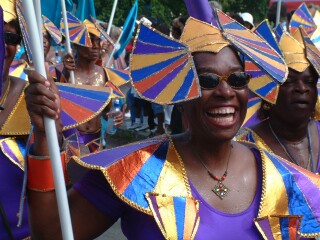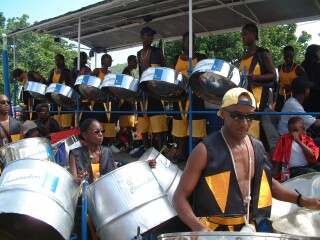

Carnival, also known as Mardi Gras, is an annual celebration on the last days before the season of Lent. Lent, a forty-day holy season observed by Roman Catholics around the world, is a time of self-denial and abstinence from merrymaking. Mardi Gras, as it is called in Europe and the US, or Carnival, as South America and the Caribbean call it, is the last chance for indulgence and revelry before the temperance of Lent. However, it is no longer confined to only those days before Lent; many Carnivals are held at other times of the year.
The term Mardi Gras refers to a single day, which is also known as Shrove Tuesday. However, Mardi Gras and Carnival celebrations take place over several days, culminating on Shrove Tuesday under the old system, or on another day important to that region. The celebrations last different amounts of time in different areas, but tend to be between three days and two weeks long.
 Pre-Lenten
celebrations have a long history; their earliest forms
appeared in the European Middle Ages, about a millennium ago. They have
developed in different ways at different rates around the world, but share the
same general beginnings. Originally, lavish parties, with the guests often in
masks and/or costumes, were held in Europe. As the European colonies spread
across the Atlantic, they brought these traditions with them. However, over the
next few centuries, the traditions diverged, modified by outside influences and
new ideas that gave each area a unique celebration.
Pre-Lenten
celebrations have a long history; their earliest forms
appeared in the European Middle Ages, about a millennium ago. They have
developed in different ways at different rates around the world, but share the
same general beginnings. Originally, lavish parties, with the guests often in
masks and/or costumes, were held in Europe. As the European colonies spread
across the Atlantic, they brought these traditions with them. However, over the
next few centuries, the traditions diverged, modified by outside influences and
new ideas that gave each area a unique celebration.
At present, most Carnival traditions are similar, but each part of the world may have its own particular differences, and often enough the holidays are held at different times of the year. In Cuba, for example, it is celebrated in July to commemorate the revolution of the late 1950s. The rest of the Caribbean generally has Carnivals spaced out in such a way that they won’t overlap with anything else, allowing people to visit and enjoy the various slightly different celebrations on different islands. In Europe and the US, it is still celebrated right before Lent.
 One
of the things that varies most from place to place is the
music associated with Carnival. Cuba has Spanish, African, and Chinese
influence, and plays a variation of Congo music on a variety of percussion
instruments and a Chinese instrument like an oboe. The southern Caribbean
islands have lots of steel drum music, which originated in Trinidad. Brazilian
Carnival music and dance (known as samba) originated in the slums of Rio, and is
now displayed in huge outdoor theater and considered among the most important
parts of Brazil’s Carnival. In the US, parades depicting scenes from mythology
and sometimes satire are held by day or night and organized by private krewes.
Such parades are dominated by dancers and banners in the colors green, gold, and
purple, and often followed by elaborate, private balls. These are important
parts of New Orleans Mardi Gras. Various traditional African, Native American,
and Cajun (descended from French Canadian) traditions have worked their way into
Mardi Gras around the US as well, with costumes, dances, and parties.
One
of the things that varies most from place to place is the
music associated with Carnival. Cuba has Spanish, African, and Chinese
influence, and plays a variation of Congo music on a variety of percussion
instruments and a Chinese instrument like an oboe. The southern Caribbean
islands have lots of steel drum music, which originated in Trinidad. Brazilian
Carnival music and dance (known as samba) originated in the slums of Rio, and is
now displayed in huge outdoor theater and considered among the most important
parts of Brazil’s Carnival. In the US, parades depicting scenes from mythology
and sometimes satire are held by day or night and organized by private krewes.
Such parades are dominated by dancers and banners in the colors green, gold, and
purple, and often followed by elaborate, private balls. These are important
parts of New Orleans Mardi Gras. Various traditional African, Native American,
and Cajun (descended from French Canadian) traditions have worked their way into
Mardi Gras around the US as well, with costumes, dances, and parties.
A few things are fairly universal concerning Carnival, however. Carnival almost always involves dancing, music, costumes, and partying in the streets. It is generally a public event, with every person having a chance to participate. There is often a particular set of music and dancing that is reserved for that time of year. Perhaps most importantly, Carnival is usually an event that can be enjoyed by all, regardless of race, class, or nationality. Indeed, many carnivals actively try to bring in tourists, and are stimulating to the local economy. All in all, Carnival is seen almost worldwide as a time to enjoy.
Top Level: Home | Destinations | Cruising Info | Underwater | Boat Guests | Ocelot | Sue | Jon | Amanda | Chris | Site Map | Make a Comment
|
If our information is useful, you can help by making a donation |
Copyright © 2000‑2025 Contact: Jon and Sue Hacking -- HackingFamily.com, svOcelot.com. All rights reserved.